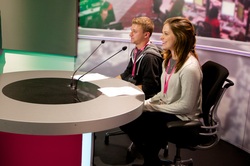
Ethics students on Wednesday 28 May saw the gold standard in broadcasting: the BBC.
Part of what makes the BBC distinctive is its global scope. It began in 1922 at the zenith of the British Empire, and thus was born with an international scope. Unlike U.S. media, which tend to presume an event is news only if an American is involved, the BBC covers the world simply to help people know about it.
A second part of what makes the BBC distinctive is its financing. In the United Kingdom, the “Beeb” is financed by a licensing fees pay by television owners. It is supported neither by advertising nor by state subsidies. It is financed by its viewers.
A third and perhaps most important distinctive is the BBC arose out of a belief that broadcasting is a public service. We saw a Latin inscription in the BBC Broadcasting House that proclaims its public service mission.
By comparison, the United States has always seen broadcasting as a corporate good. Broadcasters pay nothing for the right to use a scarce resource, the public airwaves. They’re supposed to provide a public service in exchange for that broadcast license, but bare-boned newsrooms and dubious declarations that children’s cartoons constitute “educational” television challenge that narrative.
The tour offered a meaningful look at the BBC newsroom, a fancy new 24/7 facility created just two years ago. Journalists from radio, TV and the Web work in the same large newsroom but largely focus on their own platforms.
The BBC still devotes considerable resources to radio — and not just news. It also hosts live radio shows and radio dramas.
Tour participants can try being a news reader or weather presenter, and reading a radio script or supplying sound effects. For our students, the TV set revealed that reading a live script is harder than it looks while the radio studio brought out the hams.
Along the way, students also heard a re-creation of a World War 2 broadcast when the BBC Broadcasting House was bombed, saw the original microphones used for the first national radio address by the king and saw a rooftop memorial for broadcasters killed in the line of duty.
Only 25 people can go on a tour at a time, so our group of 40 was split into two groups. The group I was in had Stephen and Debbie as tour guides, and they were excellent. It would appear the BBC is also the gold standard for informative, hands-on tours.
(Click on each image below to enlarge.)
Part of what makes the BBC distinctive is its global scope. It began in 1922 at the zenith of the British Empire, and thus was born with an international scope. Unlike U.S. media, which tend to presume an event is news only if an American is involved, the BBC covers the world simply to help people know about it.
A second part of what makes the BBC distinctive is its financing. In the United Kingdom, the “Beeb” is financed by a licensing fees pay by television owners. It is supported neither by advertising nor by state subsidies. It is financed by its viewers.
A third and perhaps most important distinctive is the BBC arose out of a belief that broadcasting is a public service. We saw a Latin inscription in the BBC Broadcasting House that proclaims its public service mission.
By comparison, the United States has always seen broadcasting as a corporate good. Broadcasters pay nothing for the right to use a scarce resource, the public airwaves. They’re supposed to provide a public service in exchange for that broadcast license, but bare-boned newsrooms and dubious declarations that children’s cartoons constitute “educational” television challenge that narrative.
The tour offered a meaningful look at the BBC newsroom, a fancy new 24/7 facility created just two years ago. Journalists from radio, TV and the Web work in the same large newsroom but largely focus on their own platforms.
The BBC still devotes considerable resources to radio — and not just news. It also hosts live radio shows and radio dramas.
Tour participants can try being a news reader or weather presenter, and reading a radio script or supplying sound effects. For our students, the TV set revealed that reading a live script is harder than it looks while the radio studio brought out the hams.
Along the way, students also heard a re-creation of a World War 2 broadcast when the BBC Broadcasting House was bombed, saw the original microphones used for the first national radio address by the king and saw a rooftop memorial for broadcasters killed in the line of duty.
Only 25 people can go on a tour at a time, so our group of 40 was split into two groups. The group I was in had Stephen and Debbie as tour guides, and they were excellent. It would appear the BBC is also the gold standard for informative, hands-on tours.
(Click on each image below to enlarge.)
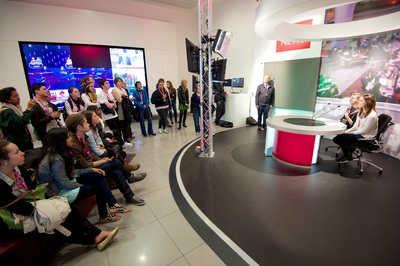
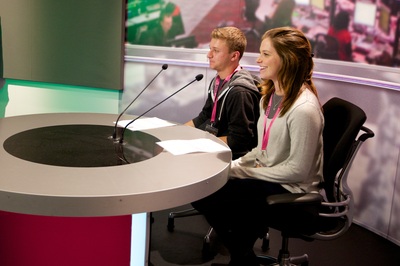
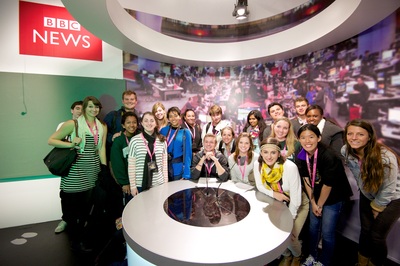
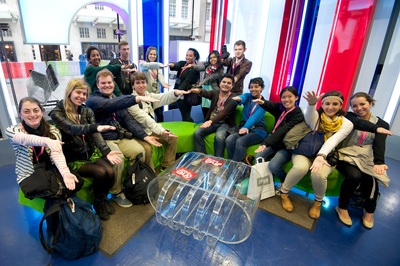
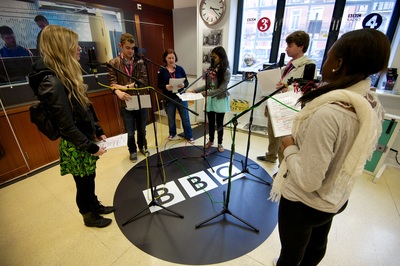
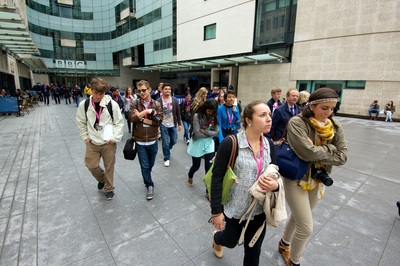
 RSS Feed
RSS Feed